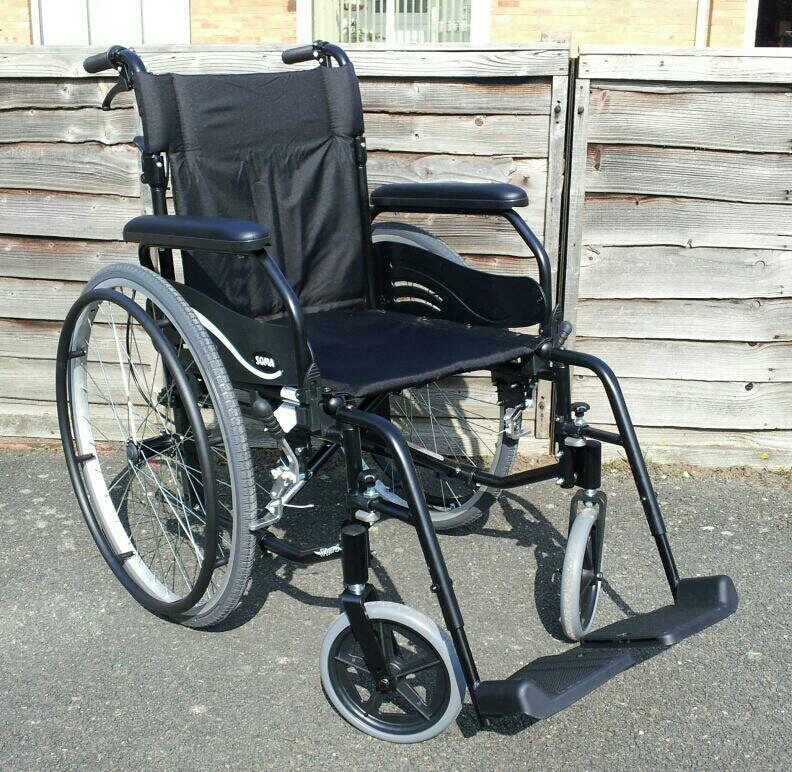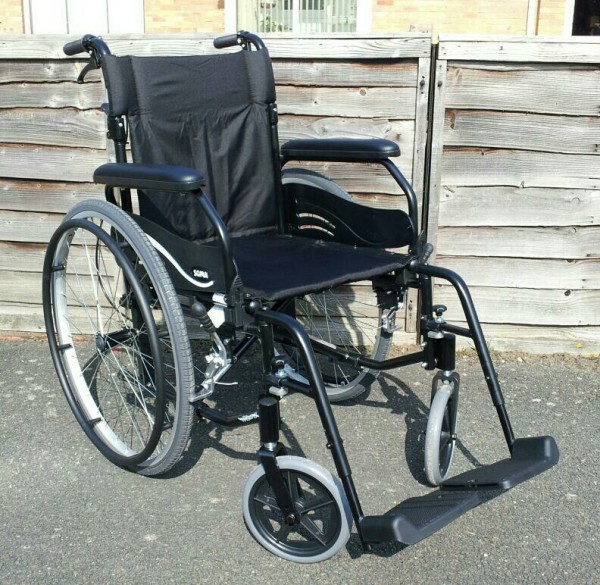
Today my sister used a wheelchair for the first time. (We share the same inherited mitochondrial condition.) Her husband has little experience of pushing a wheelchair so I tried to give him some tips, which resulted in what I have written below. Believe it or not there is actually some skill involved in pushing a wheelchair and keeping the person in it comfortable. These are just observations from my own experience of being in a wheelchair pushed by someone else, but everyone is different. If you’re pushing a wheelchair for someone new then you should ask them if they have any preferences.
- Communicate. Ask if there’s anything you need to know first. NEVER touch or move a wheelchair without permission.
- Don’t overshoot checkouts and reception desks. If you are level, your passenger has gone too far past it.
- Don’t bump your passenger’s feet into people, objects or walls. Particularly in lifts.
- Don’t follow anyone too closely. (See previous point.) Your passenger is closer to them than you are, and seeing backsides that close gets tedious.
- Watch out for oddly sloping pavements, especially near dropped kerbs. The wheelchair WILL veer sideways into traffic if you are not careful.
- Look ahead for bumps. Dropped kerbs are often not dropped very much. Be prepared to walk a long way around via the road.
- Always approach bumps straight on. If you are not lined up, stop and turn first.
- It can be easier to go backwards over bumps if the wheelchair has large wheels.
- Pay attention to the surface you travel over and take the smoother path. Cobbles can be painful or tiring for someone in a wheelchair.
- Don’t let the wheelchair run out of control. Consider taking slopes backwards so you can hold back the wheelchair. CHECK FIRST!
- If your passenger says stop, STOP immediately. (And, indeed, follow other instructions - see comments below.)
- Try going through heavy doors backwards so you can push the door with your body.
- Some wheelchairs have brakes operated by the passenger. Never assume that those brakes are on or off, always check.
- If someone speaks to you when they should speak to your passenger, tell them so.
- Be forgiving of your passenger. They have no control and that may make them grumpy. Wheelchair users: be aware that you might be shouting at your assistant more than you realise.
- If you’re pushing a wheelchair very far then you’ll probably want to get some gloves.
Thanks to @knitswift, @chmasu, @missnfranchised, @lisybabe.



As an addendum to 9 and 10: It’s not just stop. If the person in the wheelchair tells you to do something: Do it.
If someone tried to take me down a slope backwards, I’d get out of my wheelchair, walk round to them, and rip their throat out. I hate it. I panic. I feel like I’m going to crash and die. (Related to an accident I had going down a slope backwards where I ended up flat on my face in the middle of the road with a seriously displaced broken humerus.)
If you’re pushing me and I tell you that I want to go down that ramp forwards, not backwards: I mean it.
If I tell you to slow down pushing me over bumpy terrain because my front wheels are catching and it’s only a matter of time before I get tipped out: I mean it. Slow down.
I’d also renumber the points to create a new point one: Never just grab someone and push them. Always ask for consent. That is *the* most important point as far as I’m concerned.
Good list. Reminds me of the many reasons I hate being pushed in a wheelchair. Unfortunately it is a necessity at times as we cannot transport my electric one everywhere!
One further comment is that it can be hard for the “pusher” to hear the “passenger”, particularly in noisy environments (simply because we’re looking away from one another and at different heights).
So as the pusher, make sure to carefully listen out for any instructions such as “look out, stop!” and as the passenger, make sure to shout them out loudly enough!
Also, as the passenger, try not to get frustrated at the inability to have a conversation which doesn’t have “what did you say?!” interspersed every second sentence.
Excellent advice, I’ll try to keep that in mind! I haven’t pushed a wheelchair since I was a kid, with my grandmother in it. I bet I’ve made a number of mistakes back then. More recently, I’ve made mistakes with blind people, grabbing their arm when they ask me for directions, even distracting their guide dog and other such nonsense. A colleague’s wife is blind, and she gave me some important pointers, but I still managed to wave at her to say goodbye - I only noticed when her husband laughed at me. A couple months later, I saw a visually impaired neighbour in the middle of the street, and this time I managed to not just grab him, but first talk to him, ask if he actually wants my help, then offer him my arm and lead him home (he was somewhat intoxicated, which might explain how he got lost). I was damn proud that for once I didn’t make a fool of myself :-).
And I should know better. I have two kids with Down Syndrome. One of them is eleven, and people still manage to ask ME about his “condition” while he’s right there next to me and could tell them himself.
What it boils down to: Most of the mistakes are not intentional, it’s just a lack of experience.
This is great. I added it and some ‘advanced tips’ on my blog http://livingwithdisability.tumblr.com/post/123976165148/tips-for-first-time-wheelchair-pushers-this-is-a Feel free to add them here if you want to.
I would add that if you have to stop somewhere and walk away for a minute, make sure your passenger is NOT facing a corner or blank wall, especially if they can’t turn themselves around. Turn them towards where the action is going on, or in the direction you’ll be heading. Also, make sure they know you’re walking away for a minute. They can’t see you and may be wondering why they’re suddenly in time-out.
Here’s another one: discuss the destination and route with the person in the wheelchair. He or she may know the way better than you or you might be headed to the wrong place entirely. Clarify first, then consult together if there’s any confusion along the way instead of pushing on without saying anything.
Having had experience with several different kinds of chairs I think it should be mentioned that the kind shown is not very comfortable either for the sitter or the pusher. Those were designed for the convenience of folding up out of the way for institutional use. Having a well designed chair that moves easily and is made to fit the body and abilities of the user will make the use of the chair better for its owner and anyone they trust to help them.
I’m pretty sure that’s not a pic of a random chair, y’know. Also, it’s very difficult to get a decent chair out of the NHS in most regions. =/
I’d like to add: please walk round and face me to have a conversation - having to crane my neck round is not fun!
Also, to the ex-partner who thought racing me over bumpy grass when I had 2 broken feet was ‘fun’: why did I ever date you?! (bumpy surfaces make footrests jolt around separately to the seat, and the chair flexes a lot more than non-wheelchair users expect.)